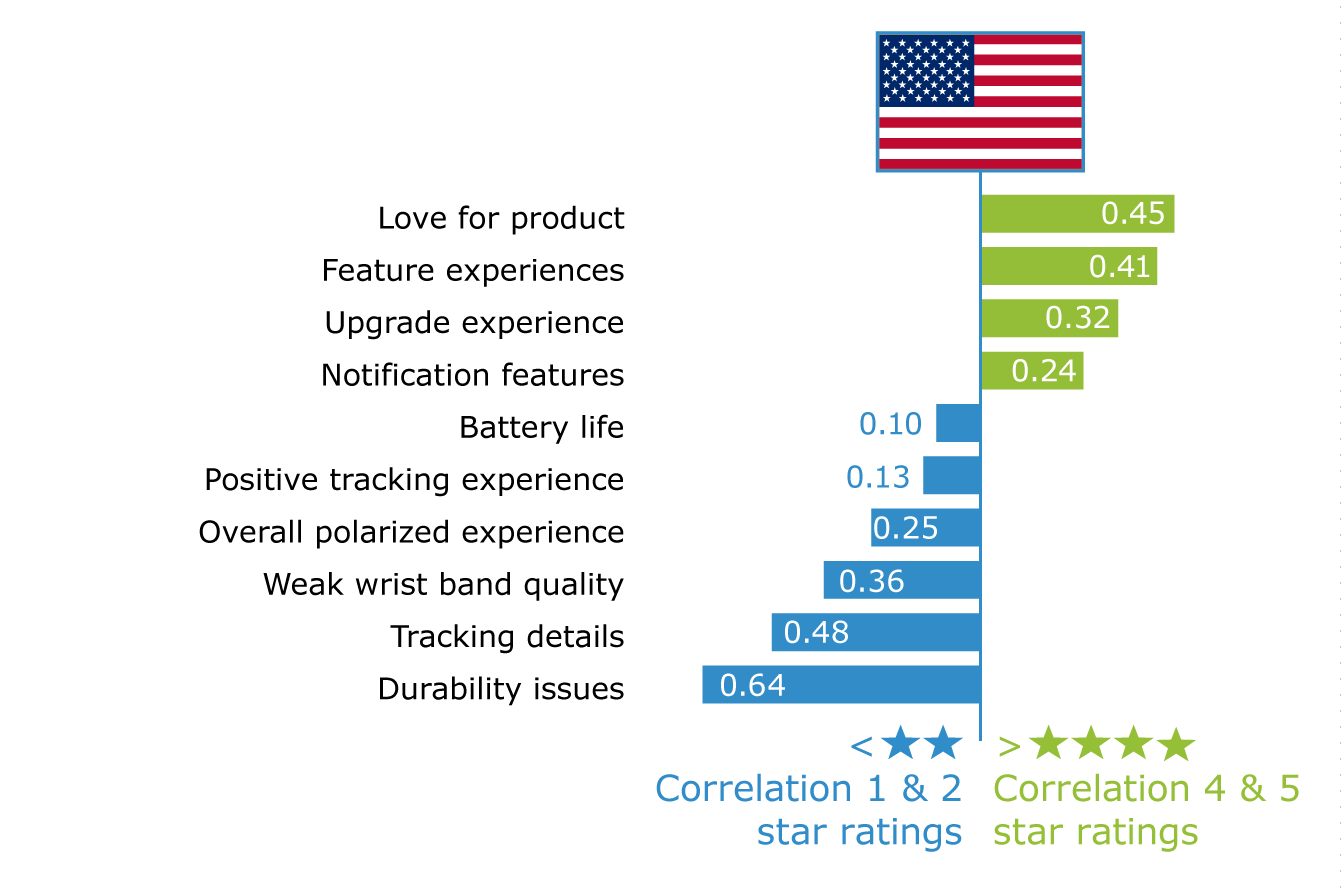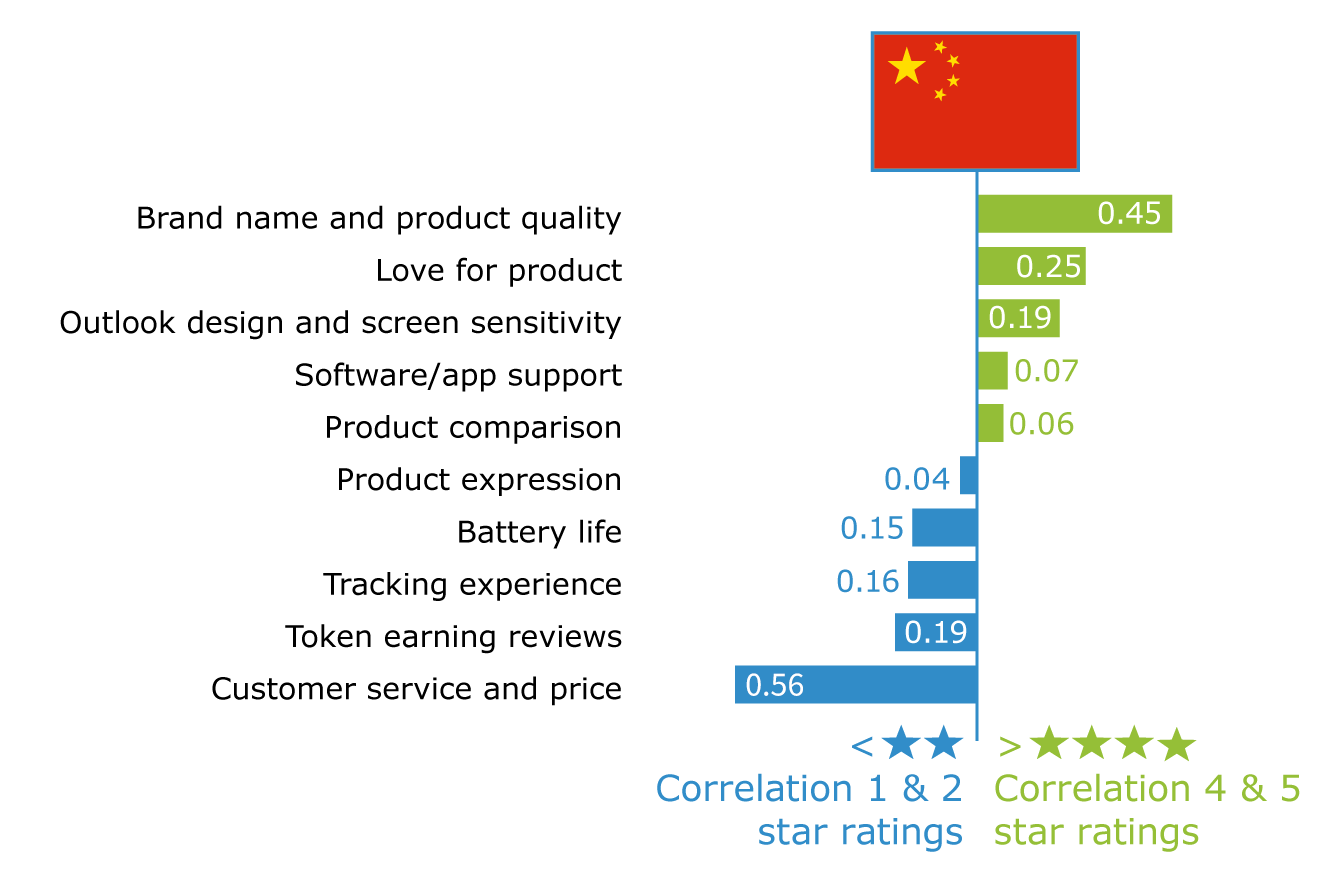Harnessing the power of augmented intelligence to understand the drivers of online review ratings

One of the biggest challenges facing marketers in all sectors is how to improve their products’ online review ratings. Numerous studies have shown a strong correlation between high ratings/satisfaction levels and sales. Understanding what drives positive reviews and ratings is therefore paramount.
In this paper, we demonstrate how automated topic modeling/artificial intelligence (AI) and human analysis combined can reveal this. We refer to this powerful combination as “augmented intelligence”.
We share the findings of a client study that used this approach to assess the performance of a competitor’s activity tracker/health watch. The aim of this two-country study conducted in the US using Amazon.com and China using JD.com was to:
- Identify the topics/drivers of both positive and negative consumer appraisals
- Determine the influence of those topics on review ratings
- Establish the differences between Chinese and American consumers’ reviews of both models of fitness watch
Realizing the power of augmented analysis
Until now, marketers have used customer care dashboards to monitor ratings, reviews and social media. Traditionally, automated counts have been used to assess the product ratings and reviews achieved. Such tools are useful for uncovering insights quickly, but these typically lack real depth. Where deeper insights have been needed, human analysis has been used. This method, however, is more costly and time-consuming. In short, both methods have their strengths and weaknesses.
In response to this problem, we’ve developed a robust and scalable approach that combines the best of both methods. Using a combination of groundbreaking AI technology and human analysis, we provide detailed insight into the subject matter of reviews. This augmented intelligence provides a more accurate picture of what drives high ratings and positive reviews for products.
Research methodology


We used this approach for one of our clients to assess the performance of a competitor’s activity tracker/health watch. The research was carried out in three distinct phases:

One: Data collection and topic modeling/artificial intelligence
First, we gathered a total for 4,000 reviews for the selected activity tracker. These consisted of 2,000 reviews per fitness watch in each market. Three-star reviews, which are considered neutral, were excluded from the sample. By doing so, we could focus on the extreme ratings/satisfaction levels. That is, the positive four/five-star rated reviews and the negative one/two-star rated reviews. This approach enabled us to obtain a better understanding of the motivations behind the positive and negative reviews in each market. We then identified and clustered the core subjects of reviews in the US and China using topic modelling.

Two: Uncovering statistics to identify which topics most influence ratings
Next, we used statistical analysis to ascertain a topic’s influence on the rating. This enabled us to identify the drivers of both positive and negative ratings and reviews in both countries.

Three: Enriching insights using human analysis and interpretation
Finally, human analysis was used to reveal the core topics that had the power to deliver high and low ratings. Sentiment analysis was conducted at the level of individual posts and based on complete reviews. This new approach enabled us to pinpoint the key drivers of high and low ratings for each of the fitness watches in each market.
Uncovering the core topics for (dis-) satisfaction and the impact on the
Amazon/JD star rating
The drivers of positive reviews
Fig. 1 – Identifying the topics of positive reviews in the US

In the US, love for the product and positive experiences relating to feature/software upgrades both emerged as key topic clusters (Fig. 1). Together, they accounted for 66% of the positive reviews about both models. More than one in five (21%) posts were about love for the product. 19% of posts were about positive experiences relating to feature/software upgrades. Specifically, customers liked the improved visuals and designs offered by the upgrades.
In China, the brand and quality of the product was the chief subject of positive reviews. Indeed, we identified that a significant number of Chinese consumers buy the product simply because of the brand. This topic accounted for 28% of positive reviews about both models.
The drivers of negative reviews
In the US, the durability emerged as the chief topic of negative comments. This accounted for 9% of such reviews. Consumers mainly complained that their watch broke after a short time.
In contrast, Chinese consumers were found to be more likely to complain about customer service and pricing. Consumers commented that the prices fluctuated and were too high. However, when the product was discounted, buyers found the reduced price as more acceptable and their reviews were also more positive. We discovered that offering a discount only solved the first barrier of the purchase process. The main obstacle was that customer service employees failed to help consumers activate their discount. This factor was preventing the positive reviews that can increase brand and product preference, and ultimately drive purchase.
A key insight was the difference in reviews between the US and China about the watch wristbands. The quality of the wristband was a key cause of negative reviews by American consumers. Chinese consumers, on the other hand, talked about the wristbands as a fashion item. They were not concerned by its poor quality as they bought a replacement new, fashionable wristband either at the same time, or shortly after, the purchase of their device.

The philosophy of Confucius: Other factors impacting Chinese reviews
Our analysts noticed that Chinese consumers, unlike US consumers, pasted unrelated text into their reviews. In example, one Chinese consumer quoted the philosopher Confucius in a comment about the wristband of one of the watches. This behavior was the result of JD.com rewarding consumers for posting longer product reviews. This activity underlines the importance of human analysis in drawing insights from consumer reviews.
The influence of topics on ratings
Having identified the core topics of reviews in both markets, we used statistical analysis to pinpoint their influence on ratings.
Charts Fig. 2 and 3 show the correlation between the subjects discussed in reviews and their star rating. In the US, love for the product and feature experiences can be seen to correlate strongly to four/five–star ratings. In China, it is the brand and quality of the product that achieves the highest ratings. In both countries, however, the strongest correlations appear between the topics of negative reviews and one/ two–star ratings.
Key insights – take-outs
Our research identified clear correlations between key topics and star ratings in each market. Through human analysis, we determined those ‘moments of delight’ for consumers as well as their pain points. Based on this information we made clear recommendations to our client. These included:
- Focusing on durability to gain competitive advantage
- Developing a more robust wristband to improve their market positioning
- Optimizing the accuracy of their tracking data and battery life
- Reviewing their price position
With this information, our client could guide their own innovation and marketing plans to differentiate their brand in each market. In turn, they could ensure they were meeting the needs and expectations of consumers in both the US and China. In doing so, they have the power to positively influence their product reviews and ratings, and so drive sales.
Harnessing the power of augmented intelligence
Cost-effective and
efficient way to
understand what drives
star ratings
Helps to identify
opportunities including
areas for improvement/
development
Uncovers the real story
and sentiment behind
reviews – both positive
and negative
Robust methodology
Enables brands
to pinpoint the
exact drivers of
customer satisfaction
Offers a clear path to
improved ratings and
sales success
Authors


Want to know more?
We’re just a chat/email/call away
Contact one of our expertsAbout MetrixLab
MetrixLab provides consumer insights that drive smarter business decisions. A truly global digital research agency, we pioneer new technologies and integrate multiple data sources to push the boundaries of research. This enables our experts to provide high-quality insights at scale, at speed and for an unparalleled value. Our passion, expertise, and solutions enable our clients to succeed at product innovation, brand engagement, and consumer value.
Active in over 90 countries, MetrixLab is a proud partner of more than half of the world’s top 100 brands and part of Toluna.
Download PDF© Perfectly Possible Designs Ltd




